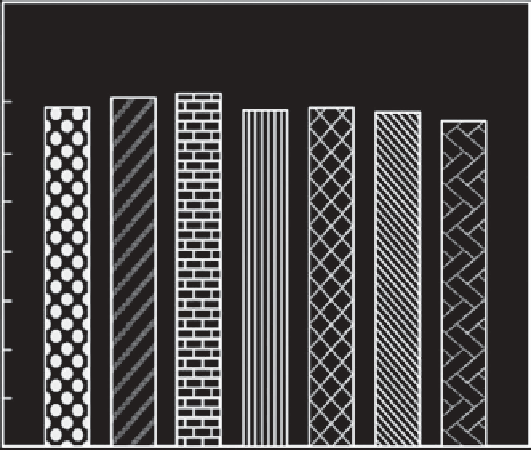Agriculture Reference
In-Depth Information
a
a
ab
ab
ab
ab
b
7000
6000
5000
4000
3000
2000
1000
0
T
1
T
2
T
3
T
4
T
5
T
6
T
7
Nitrogen treatments
FIGURE 8.19
Grain yield of lowland rice as influenced by N timing treatments. T
1
= all the N applied
at sowing, T
2
= 1/3 N applied at sowing + 1/3 N applied at active tillering + 1/3 N applied at the initiation
of panicle primordia, T
3
= 1/2 N applied at sowing + 1/2 N applied at active tillering, T
4
= 1/2 N applied at
sowing + 1/2 N applied at the initiation of panicle primordia, T
5
= 2/3 N applied at sowing + 1/3 N applied at
active tillering, T
6
= 2/3 N applied at sowing + 1/3 N applied at initiation of primordia floral, and T
7
= 1/3 N
applied at sowing + 2/3 N applied at 20 days after sowing. (Adapted from Fageria, N. K. and A. S. Prabhu.
2004.
Pesq. Agropec. Bras
. 39:123-129.)
at initiation of panicle primordial) was 49% higher compared to control treatment and 13% higher
compared to the highest-yielding 150 kg N ha
−1
(one-third at sowing + one-third at 45 days after
sowing + one-third at initiation of panicle primordial). Fageria and Baligar (2005) and Fageria et al.
(2011a) reported that the maximum grain yield of lowland rice under Brazilian conditions was
obtained with the addition of 200 kg N ha
−1
. Fageria and Baligar (2001b) also reported a significant
quadratic response of lowland rice yields in a Brazilian Inceptisol when the N fertilizer was applied
in the range of 0-210 kg ha
−1
.
Meyers (1992) reviewed a series of flooded rice experiments in Indonesia and concluded that
there are technical solutions to increase nitrogen use efficiency. One solution is to use various
split applications and another is to place N deep into the soil to increase nitrogen use efficiency.
Nyiraneza et al. (2010) reported that split application of the N fertilizer can help to synchronize N
supply with wheat N demand. Because crops, including wheat, remove around 50% of the applied
N fertilizer, unused N can be lost through leaching, denitrification, or volatilization.
8.3.5 n
ItrIfICatIon
I
nhIBItors
The use of nitrification inhibitors may be one of the options to improve nitrogen use efficiency in
crop plants. There is plenty of literature showing positive as well as no effects of nitrification inhibi-
tors on N use efficiency in crop plants. For example, slow-release N fertilizer developed by coating
urea granules with sulfur has been tested for rice and was found to be superior to common urea
in almost all types of soils (Bijay-Singh and Katyal, 1987). Thind et al. (2010) reported that neem
(
Azadirachta indica
)-coated urea applied to rice can result in high N use efficiency as it contains

